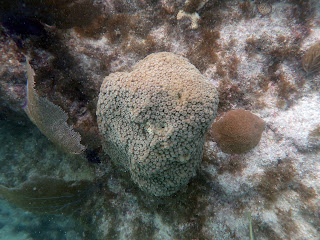 |
| Bermuda Chub and Yellowtail Snapper Photo: Dr. Joshua Voss |
Sombrero Reef is a
barrier reef in the Atlantic off the coast of Marathon Key. The water on the
reef was clear, though the wind made the surface choppy. Even beneath the
surface, the system was still high energy, and tossed around divers. Barrier
reefs like this one decrease wave energy as they approach shore, protecting the
coastline from waves like the ones we experienced. Depths ranged from 2.5 to
3.5 meters. The bottom of the reef was sandy, with a diverse coral community.
This sediment was finer than other sites visited, as it was created by
bioeroders such as parrotfish feeding on the corals.
 |
| Dendrogyra cylindrus Photo: Dr. Joshua Voss |
 |
| Palythoa caribaeorum on Sombrero Reef Photo: Dr. Joshua Voss |
The reef provided
a diverse habitat for many species of fish, including multiple species of
Angelfish, Butterflyfish, and Damselfish, as well as others. Yellowtail snapper
and Bermuda Chub were easy to observe because they swam right up to the boat to
eat the results of numerous cases of seasickness. On the bottom, the corals
included Dendrogyra cylindrus (Pillar
coral), Montastrea cavernosa, and Sidastrea siderea, though in total there
were around sixteen species. Competing
with the coral for space was Palythoa
caribaeorum, a hydrozoan which superficially appears similar to coral but
does not calcify. The algal diversity was limited on the reef, but included
some Sargassum, Halimeda, and various
Cyanobacteria.



No comments:
Post a Comment